|

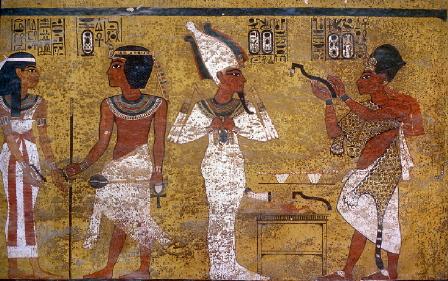
Nut greeting Tutankhamun (left to right)
Burial chamber: rear wall (center part)
New Kingdom, Dynasty 18
Valley
of the Kings East Valley, Thebes West Bank, Thebes
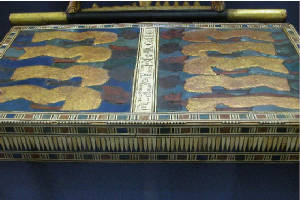
The Golden Throne
This chair is by far the most spectacular of the six found
in Tutankhamun's tomb. The wood frame was wrapped with sheets of gold and silver and then inlaid with an array of semiprecious
stones, faience and colored glass, which together were worked into a wealth of symbolic and decorative elements. Finely detailed
lion's legs support the chair, while the arm panels take the form of winged uraei (or cobras) surmounted by
the double crown of Upper and Lower Egypt. Partially visible is the exquisitely rendered chair back, which depicts Queen Ankhesenamun
anointing her husband beneath the life-giving rays of the sun disc.
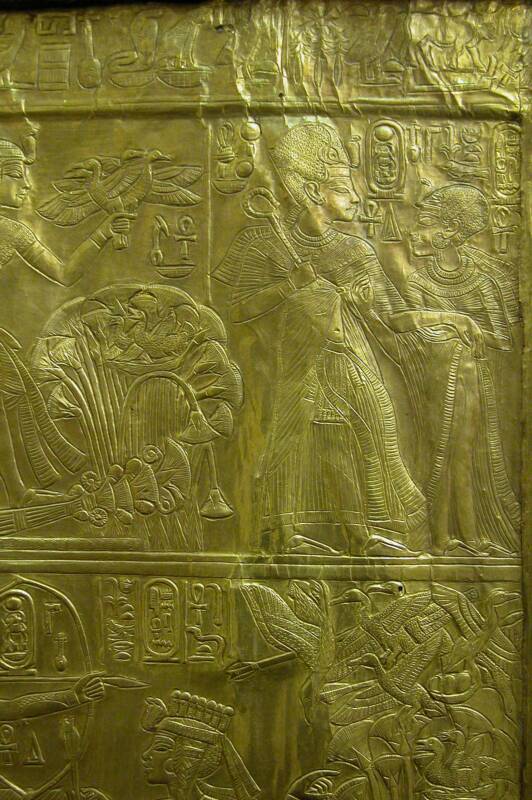
Exterior of shrine (above) showing two representations of the
King and Queen. Kemet (Egypt), as part of African culture in general, tended to give women unusual status and importance.
The representation of King Tut and Queen Ankhesenamon, for example, show the queen having a far more important presence than
we would expect in the art of Western Asia, for example.
Queen Nefertiti had six daughters; King Tut married one of them, his half sister. Ankhesenamon
was thirteen years old when she became the wife of Tutankhamun when he was only nine years old. Tutankhamun succeeded Smenkhkare
in 1334 B.C., but only ruled about 10 years. The teenage queen apparently suffered two failed pregnancies: the miscarriage
of a 5-month-old female fetus and a stillborn baby girl. (Both were mummified and buried in Tutankhamun’s tomb.)
King Tut was born most likely in city of Ankhetaten (present-day
Tell el-Amarna). Little is known of Tut’s childhood. There is considerable archaeological and textual evidence indicating
that King Tut was the grandson of Queen Tiye. King Tut's parents was probably King Akhenaten, and a secondary wife Queen Kiya. See also King Tut's family tree.
King Tut died around 1325 B.C. at the age of about 18 [source], leaving behind a mystery of his death. English archaeologist Howard
Carter and his excavation team in 1922 had badly mangled the mummy of Tut. A bone fragment detected in his skull during a
1968 X-ray was caused not by a blow, but by the embalmers or by Carter’s rough treatment.
After King Tutankhamun died, Queen Ankhesenamon took some drastic
measures perhaps because she was afraid of the priests and the power of general Horemhab, which was growing. Horemhab was
stirring up opposition to Amarna and the worship of the god Aten. Ankhesenamon wrote to the chief of the Hittites, Suppiluliuma,
who was an emerging power in the northern Mediterranean. She offered herself and the throne of Egypt to one of his sons. Prince
Zananza set out for Egypt, but was murdered on the border of Egypt. It is probable that he was killed by general Horemhab's
military agents.
The man chosen to succeed Tutankhamun was Kheperkheprure Ay, who was master of horse in Thebes. Ankhesenamon was given to Ay as
his bride. Some believe that Ay was the father of Queen Nefertiti, which would have made him Ankhesenamon's grandfather. Together,
they assumed the throne before Tutankhamun was buried. Kheperkheprure Ay died in 1319 B.C., but Ankhesenamon disappeared before
his death. She was replaced by Kheperkheprure Ay's wife, Tey.
|
 |
|
|
|
 |
Colossal Statue of Black King Tutankhamun
Quartzite, pigment
New Kingdom, Dynasty 18, reign of Tutankhamun, 1334 B.C.
Luxor, Medinet Habu, temple of Aye and Horemheb
Excavated by the Oriental Institute, 1930
This colossal statue represents Tutankhamun, one of the most famous pharaohs
of ancient Egypt. It portrays the king standing with his left foot advanced, a typical pose in ancient Egyptian sculpture.
Tutankhamun wears a striped head cover (nemes) topped by the double crown which symbolizes his sovereignty over northern and southern Egypt. He
also wears a beaded collar and a pleated kilt. A dagger with a falcon head - the symbol of the gods Horus and Re - is stuck
in his waistband. The king grasps truncated cylinders that may represent document cases or scepters. Traces of feet on top
of the base to the king's left indicate that a smaller scale statue of his wife once stood by his side. The colossal statue
is seventeen feet, four inches high, making it the tallest ancient Egyptian statue in the Western Hemisphere. It weighs approximately
6 tons (12,000 pounds).
One of two nearly identical colossal images, this statue was excavated by the Oriental
Institute from the ruins of an ancient temple built in western Thebes (modern Luxor). Because two such statues were excavated,
the Egyptian government gave one of the pair to the Oriental Institute. The other statue is in the Egyptian Museum, Cairo.
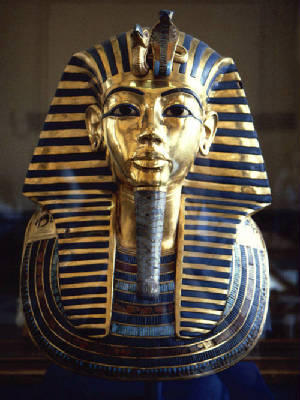
Death mask of Tutankhamun, was placed over the head and shoulders
of his mummy. It is inlaid with blue glass and lapis lazuli.
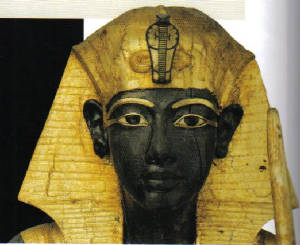
One of a pair of life sized statues of Tutankhamun that were
found either side of the entrance to the burial chamber. This one stood at the right hand side.
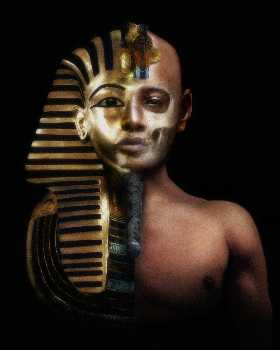
Feast your eyes on the face that hasn't been seen for 30 centuries
and see how the latest medical science is shedding light on the man behind the mask. Scientists and special-effects experts
on three continents have teamed up to recreate a face which they say is the closest image yet of the boy king.
Egypt's most famous face has been brought back to life with
the help of facial-reconstruction expert Dr. Robin Richards.
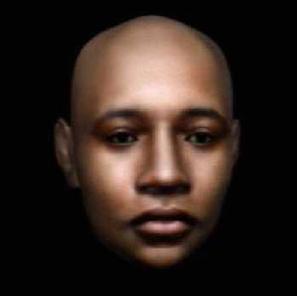
United Kingdom Reconstruction 2002
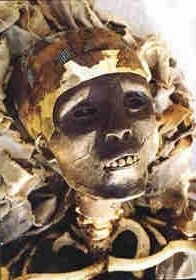
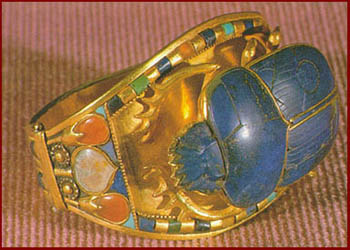
Massive hinged gold hoop-shaped bracelet found on the mummy of Tutankhamun.
Its central plaque bears a large gold scarab inlaid with lapis lazuli. All the floral and block-decoration is inlaid with
lapis lazuli, turquoise, cornelian and quartz in colored cement.
From the tomb of
Tutankhamun, Valley of the Kings, W. Thebes. 18th Dynasty (1334-1325 B.C.)
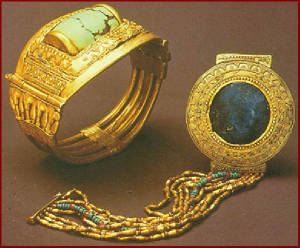
Two of the bracelets found on King Tutankhamun's arms. The massive rigid
hinged gold example (a) has a cylinder of turquoise inset into a plaque smothered with applied wire and granulation. The other
(b) has a flexible strap of gold and glass beads attached to a circular gold plaque, also highly decorated, with a central
lapis lazuli inset.
From the tomb of Tutankhamun, Valley of the Kings,
W. Thebes. 18th Dynasty (1334-1325 B.C.)
|
 |
|
|
|

